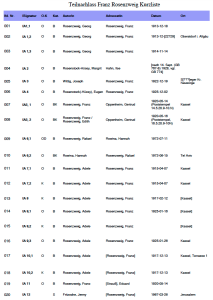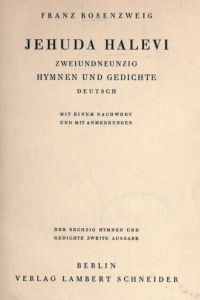Franz Rosenzweig’s cultural and intellectual legacy rests on his theological-philosophical masterpiece, The Star of Redemption (1921), his work with the Freies Jüdisches Lehrhaus in Frankfurt am Main, and, of interest to us, his translations of Judah Halevi and, with Martin Buber, the Hebrew Bible. A decade after his near conversion to Christianity (see Pollock 2014), Roseznweig came to the theory and practice of translation following his establishment as a German-Jewish intellectual with Star of Redemption and as part of his larger project to demonstrate and enact the enduring relevance of Judaism as a system of redemption in the modern world. Indeed, as we shall explore in below, translation for Rosenzweig works to renew in the present the truth of past works and thus mediated, as Mara Benjamin points out, “the acculturation that was an established within Rosenzweig’s social class, while appealing to the search for an authentic Jewish heritage that had been seemingly lost” (2009, 66). Rosenzweig’s theory of translation and the reactions it solicited helped differentiate the landscape of Weimar-era German-Jewish thought between those invested in religious renewal (such as himself, Martin Buber, Ernst Simon, and Margarethe Susman) and the forerunners of Critical Theory (Walter Benjamin, Siegfried Kracauer, and Ernst Bloch). The development of Roesnzweig’s work on translation, and the reactions it solicited, is thus a complex and nuanced aesthetic and intellectual-historical phenomenon, a full recounting of which ultimately exceeds the scope of this investigation. Moreover, as indicated by its heavy reliance on Luther, Rosenzweig’s theory of translation serves as only one of many such theories, the scope, theory, and limits of which interested readers can learn more about in Venuti 2012 and 2013 and MacLeod and Wiggin 2015. My goal in the following is thus to sketch and tease out – for those unfamiliar with Rosenzweig – concepts that are foundational to and exemplary of his theory of translation, so that these can be mobilized to examine movements of translation I believe to be hidden but ubiquitous in the Digital Humanities.
Rosenzweig’s afterword to Jehuda Halevi: Ninety-Two Hymps and Poems (1924, 2nd expanded edition 1927) is one of the first published texts to elucidate Rosenzweig’s theory of translation. For Rosenzweig, the problem with then-contemporary practices of translation, including Emil Cohn’s 1920 transition and brief biography of Halevi, lies in their attempt to modernize, familiarize, and assimilate for the modern reader that which is foreign in a text. But such a concept of translation negates the function of renewing and expanding the boundaries of the target language through the translation of a foreign text, which Rosenzweig’s believes to be translation’s primary task. In order to retain what is Jewish in a German translation, Rosenzweig thus turns a theory that seeks through translation to update and render familiar a foreign text on its head: with his work on Halevi, Rosenzweig seeks “not to Germanize what is foreign, but rather to make foreign what is German” (1995, 170). The afterword is of consequence for us, because it provides two main ideas from Rosenzweig’s theory of translation that can apply to how we think of, or even elide, the notion of translation in the Digital Humanities.
The first of these ideas is the elimination of the poetic additions of the translator in the service of familiarization or modernization, which provides the method through which Rosenzweig hopes to “to make foreign what is German.” As Rosenzweig writes at the outset of the afterword:
It was not my aim to make the reader believe that Jehuda Halevi composed in German, nor that he composed Christian church songs, nor that he is a poet of today, even if only a Familienblatt poet of today […] In a word: this translation is not a free rendering [Nachdichtung], and yet if here and there it is so, then only for need of rhyme. Basically my intention was to translate literarily, and in approximately five-sixths of these lines of verse I may have succeeded. (169)
For instance, a faithful translation for Rosenzweig hinges on not disturbing the Hebrew meter through the inventions of “Nachdichtung” in the German: on achieving a Stefan George-like equal stress level of a silent syllable followed by stressed syllables, in contrast to the, for Rosenzweig, prototypical German “prose stress of the words” (175). Certainly, questions of meter are far afield from our focus on visualizing metadata. But the passage above prompts us to ask nonetheless: When moving information from one medium or form to another, what sorts of “Nachdichtung” do we employ – consciously or unconsciously – to make it more easily understood for a reader? What type of “Nachdichtung” is built into the programs we use? What is lost in making data more familiar or consumable to the end user? And what would it mean, in terms of data and visualizations, to “translate literally?”
The second idea Rosenzweig’s afterword offers us entails the effects of such a literal translation, in particular regarding Jewish poetry. A bit of background is necessary: Halevi’s poetry frequently cites the Bible, a practice which Rosenzweig explains as “Musivstil,” “inlaid style” or “the appearance of epochs that are literally in the age of minority” or subordinate to the text’s epoch (177, see also Benjamin 80-83). Rosenzweig’s translation style thus seeks to use “Musivstil” to turn its effect inside out:
All Jewish poetry in exile scorns to ignore this being-in-exile. It would have ignored its exile if it ever, like other poetry, took in the world directly. For the world which surrounds it is exile, and is supposed to remain so to it. And the moment that it would surrender this attitude, when it would open itself to the inflow of this world, this world would be as a home for it, and it would cease to be exile. This exiting of the surrounding world is achieved through the constant presence of the scriptural word. With the scriptural word another present thrusts itself in front of the surrounding present and downgrades the latter to an appearance, or more precisely, as parable (Rosenzweig, 177).
Enabled by the “foreignness” and “exile” retained in literal translation, the passage provides a strange inversion of lyrical time: the Biblical past becomes privileged over, indeed moves “in front of” the “surrounding present,” which in turn only signifies the Biblical past. Again, Rosenzweig’s aims here are different in their theological scope, but the idea of “inlaid style” suggests a novel way of revealing how translation works, or potentially could work, in the Digital Humanities. In other words, Rosenzweig encourages us to question the extent to which translating data takes into account, even perhaps point at, the forms and media through which the data have passed. Revealing and understanding the process by which humanistic concerns are translated into data, information, and quantity, and seeing the ways in which such data is subsequently transformed is a crucial task Rosenzweig helps us think through. The concealment of these process, even more so.
Paramount for Rosenzweig is the elimination of free rendering and the preservation of elements in the translated text regardless of their foreignness, incongruence, or awkwardness in the target language. His goals are aesthetic and theological for sure, but his approach to translation is symptomatic, if not an extreme case of a broader debate regarding the fidelity of translating materials from one medium to another. Rosenzweig thus invites us to think about translating, or visualizing the archive in ways that would retain the original character of the text, such that the rendering may be comprehensible but still strange or “foreign.” And he proposes a method of visualization that keeps the structures, peculiarities, and problems of the archive metadata and takes care not to allow the capabilities, formats, and requirements, the new “language” of the programs used in the translation, to hide, obliterate, or reframe them by making the data familiar.
At stake in working with data visualization and in theorizing it in terms of translation is more than just information about Rosenzweig or his theory of translation. Indeed, there may be other, more graceful theories of extracting, converting, and translating data in the digital age. But Rosenzweig’s archive helps us locate the position the Digital Humanities assume in the history of translation and the archive, in that it emphasizes a need to investigate the consequences of what Lisa Gitelman and Virginia Jackson call the “oxymoron of raw data” and to think through the ways in which we “cook” data through it storage and transmission – in short, to think through DH as translation. My larger project on Rosenzweig thus hopes to expose how the digital work of annotation (other project) or visualization (this project) forces us to re-examine the questions we ask about epistemology and language in traditional humanistic inquiry. It also shows how the methods of the digital humanities – refining, formatting, visualizing – reinstate and radicalize the problematic and constructed nature of the archive in general. But it shows us, too, that much as DH promises to redefine the humanities, it requires some of the most compelling discourses in the humanities, and in German Studies, to comprehend this very same redefinition.

